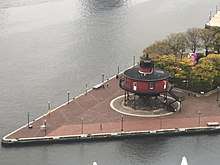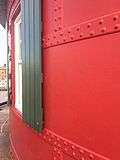Seven Foot Knoll Light
The Seven Foot Knoll Light was built in 1855 and is the oldest screw-pile lighthouse in Maryland. It was located atop Seven Foot Knoll in the Chesapeake Bay until it was replaced by a modern navigational aid and relocated to Baltimore's Inner Harbor as a museum exhibit.
.jpg) Seven Foot Knoll Light at its original location (1900) | |
  | |

| |
| Location | originally at the mouth of the Patapsco River in the Chesapeake Bay; relocated to the Inner Harbor in Baltimore, Maryland |
|---|---|
| Coordinates | 39.2836°N 76.6054°W (current) 39.1551°N 76.4091°W (original) |
| Year first lit | 1856 |
| Automated | 1949 |
| Deactivated | 1988 |
| Foundation | screw-pile |
| Construction | wrought-iron (originally cast-iron) |
| Tower shape | cylindrical house |
| Tower height | 40 ft (12 m) |
| Focal height | 17 metre |
| Original lens | fourth-order Fresnel lens |
| Range | 12 nmi (22 km; 14 mi) |
| Characteristic | Fl WR 6s |
| ARLHS number | USA-750H |
| Heritage | place listed on the National Register of Historic Places |
Seven Foot Knoll Light | |
Seven Foot Knoll Lighthouse at its present location | |
| Location | Pier 5, Inner Harbor, Baltimore, Maryland |
| Area | less than one acre |
| Built | 1875 |
| NRHP reference No. | 89001096[1] |
| Added to NRHP | August 22, 1989 |
Location
It was initially installed on a rocky shoal called Seven Foot Knoll (at 39.1572°N 76.4034°W), in the mouth of the Patapsco River. The northern tidal reach of this river is the Baltimore Harbor, where the now-decommissioned lighthouse has been placed as a museum exhibit. In 1997 the lighthouse was transferred to the Baltimore Maritime Museum (now the Historic Ships in Baltimore museum) and is permanently installed at the south end of Pier 5.

Construction

Constructed of 1-inch (25 mm) rolled iron, the lighthouse consists of three main sections. The gallery deck was located 9 feet (2.7 m) above the average high tide waters. The house was the second section, sitting directly atop the gallery deck. This is where the keeper and his family would live. Atop the housing area was the third section of the lighthouse, the light beacon. A 4th order Fresnel lens was housed in the small light compartment. It was visible for 12 nmi (22 km; 14 mi).
History
The first requests for a light came in 1848, with initial appropriations in 1851. Delays in planning and bidding pushed the start of construction to 1854. The house consisted of a cylindrical structure of wrought iron plates, with the ninth pile in the center.[2] Total construction costs came to $43,000 by its completion the following year. Most parts were fabricated in Baltimore at the Murray and Hazelhurst iron foundry. The parts were then shipped to Seven Foot Knoll by boat where they were assembled atop of the screw piles. Ice, the perennial threat to screw-pile structures, caused damage in 1884 and 1894, leading to the piling of 790 cubic yards (600 m3) of riprap around the piles.[3]
.jpg)
The light was automated in 1949, and fell into disrepair, eventually being supplanted by a skeleton tower.[4] In 1988, the lighthouse was removed from Seven Foot Knoll, carried by a 1000 Ton Capacity Shearleg derrick, and placed ashore in Baltimore's Inner Harbor where it was donated to the city. On August 22, 1989 the lighthouse was listed on the National Register of Historic Places.[1] Aided by the Lady Maryland Foundation (now the Living Classrooms Foundation), many members of the Steinhice family descendants worked to restore the structure prior to its re-opening.
The lighthouse is a contributing element in the Baltimore National Heritage Area and part of the Historic American Engineering Record.[5][6]
Rescues
Thomas Jefferson Steinhise (Keeper 1930–1941) assisted in the rescue of a tugboat crew in 1933.[7][8] The tugboat Point Breeze was then owned by the Curtis Towing Company of Baltimore.[9] She was towing a barge of dredge spoils from Baltimore to Gibson Island on August 20, 1933. The 90 mph (140 km/h) winds and 15 ft (4.6 m)) seas had overcome the tug and the crew abandoned ship. Steinhice took the lighthouse's small motorboat and made his way out in the direction of the tug's distress whistle where he pulled six crew members from the water. Five crew members survived but the engineer perished. Steinhise was awarded the Silver Lifesaving Medal for his actions in saving the lives of the stranded crew.[7][8] He is buried in Holy Cross Cemetery, Glen Burnie, MD. and his memorial includes a U.S. Lighthouse Service grave-marker.[10][11]
List of keepers
A list of Head civilian keepers.[11]
| Name | Year | Service Notes |
|---|---|---|
| Samuel Ayer | 1855–1856 | |
| George McCutchen | 1856–1860 | |
| George Seiber | 1860–1861 | |
| E. B. Lucas | 1861–1865 | |
| Thomas Cannon | 1865–1867 | |
| John H. Wills | 1867–1869 | |
| Edward B. Lucas | 1869–1870 | |
| Thomas B. Davis | 1870–1872 | |
| William Moody | 1872–1873 | |
| Joel W. McDonald | 1873–1874 | |
| James T. Bowling | 1874–1879 | |
| John C. Moffett | 1879–1881 | |
| John Peterson | 1881–1886 | |
| Henry Corson | 1886–1891 | |
| Christopher C. Butler | 1891–1892 | |
| William K. Slacum | 1892–1894 | |
| William R. Schoenfelder | 1894–1898 | |
| John Berentsen | 1898–1903 | |
| John H. Grain | 1903–1916 | |
| John L. Ennis | 1916-at least 1919 | |
| James W. Simpson | at least 1921 | |
| Otho Bounds | 1924–1930 | |
| Thomas J. Steinhise | 1930–1941 | Rescued crew of tug Point Breeze. Awarded Silver Lifesaving Medal.[11] |
See also
- List of lighthouses in Maryland
- List of lighthouses in the United States
- Lists of lighthouses and lightvessels
- Kerosene Lamp
- Position fixing
- Port of Baltimore
References
- "National Register Information System". National Register of Historic Places. National Park Service. July 9, 2010.
- "Coast Guard Lighthouses". www.uscg.mil. Retrieved 2016-12-26.
- Dennis Zembala (June 1989). "National Register of Historic Places Registration: Seven Foot Knoll Light" (PDF). Maryland Historical Trust. Retrieved 2016-03-01.
- "LIGHT LIST Volume II ATLANTIC COAST" (PDF). US Coast Guard. 2016. Retrieved 2016-12-26.
- "Baltimore National Heritage Area Map". City of Baltimore. Retrieved December 27, 2016.
- Historic American Engineering Record. "Seven Foot Knoll Lighthouse, Mouth of Patapsco River, Riviera Beach, Anne Arundel County, MD". Library of Congress. Retrieved December 27, 2016.
- Cora, Paul (2009). "Seven Foot Knoll Lighthouse: The Keepers" (PDF). The Deck Log, Volume XI, Issue #3. Retrieved 2016-12-26.
- "Tugboat Information". www.tugboatinformation.com. Retrieved 2016-12-26.
- Lighthouses, Superintendent of (1933-09-01), English: Image of a letter expressing the gratitude of the Curtis Bay Towing Company to Thomas Jefferson Steinhise., retrieved 2016-12-27
- Brown, Atalie Day. "Around Pasadena: Lighthouse hero honored with grave marker". capitalgazette.com. Retrieved 2016-12-26.
- "Seven Foot Knoll Lighthouse". LighthouseFriends. Retrieved 2016-12-30.
External links
| Wikimedia Commons has media related to Seven Foot Knoll Light. |
- Official webpage at Baltimore Maritime Museum
- "Historic Light Station Information and Photography: Maryland" (PDF). United States Coast Guard Historian's Office.
- Seven Foot Knoll Lighthouse, from the Chesapeake Chapter of the United States Lighthouse Society
- Seven Foot Knoll Lighthouse at lighthousefriends.com
- Rowlett, Russ. "Lighthouses of the United States: Maryland". The Lighthouse Directory. University of North Carolina at Chapel Hill.
- Chesapeake Bay Lighthouse Project – Seven Foot Knoll Light
- Seven Foot Knoll Lighthouse 3D Model
- Historic American Engineering Record (HAER) No. survey-MD-54, "Seven Foot Knoll Lighthouse, Mouth of Patapsco River, Riviera Beach vicinity, Anne Arundel County, MD", 37 photos, 9 data pages, 1 photo caption page
- Seven Foot Knoll Light, Baltimore City, including photo dated 1993, at Maryland Historical Trust


